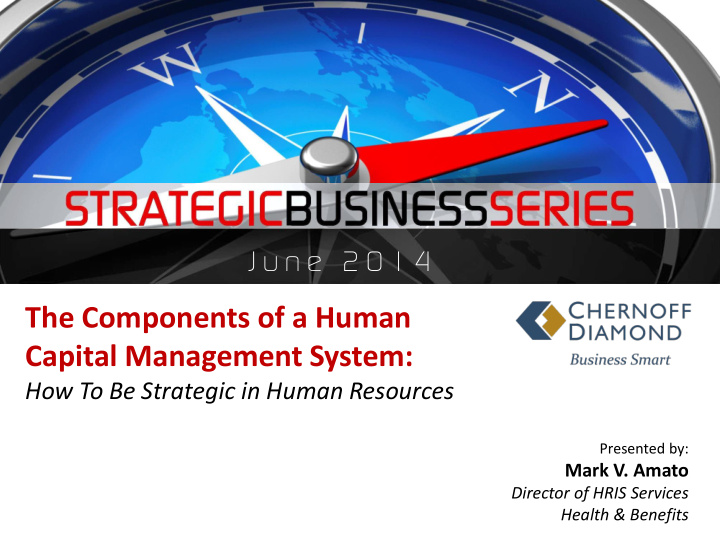



J u n e 2 0 1 4 The Components of a Human Capital Management System: How To Be Strategic in Human Resources Presented by: Mark V. Amato Director of HRIS Services Health & Benefits
What Business Leaders Talking About Today… • Affordable Care Act • Administering New Legislation (Paid Sick Leave, Wage Theft Prevention Act , 2013 New I9 form) • Collaboration • Efficiency (elimination of paper touches, redundancies and errors) • Most Important: People As Assets
The Technology & Terms • SaaS and Cloud Based Systems • Pre boarding / On Boarding / Off Boarding • Manager and Employee Self Service • Portals and Links • Device Agnostic Solutions
The Components Which Ones Apply To Your Organization?
The Components Recruiting & Applicant Tracking Pre Boarding Requisitions Interview Job Postings Approvals Internal & Hire/Reject External
The Components On Boarding – Employee Orientation – Document Management – Benefits Enrollment
The Components Benefits Administration – Payroll Interface/Integration – Carrier Connections – Open Enrollment (on-line)
The Components Performance & Talent Management – Performance Reviews – Training and Education – Compensation “ 85% of all employees in the United States have no idea what their companies goals are!”
The Components Time & Labor – Payroll – Time Off – Time Keeping
The Components
Tracking (Full-Time) Employee Population • Full-Time Employee – 30 hours of service per week – 130 hours of service per calendar month • Look-Back Measurement Method – Tracks hour in prior period • Measurement Period – Determine offer of coverage in successive period • Stability Period
New Reporting for Calendar 2015 • IRC 6055 Information Reporting of Minimum Essential Coverage – IRS to determine individual mandate penalty – Carrier or plan sponsor (self-funded) • IRC 6056 Information Reporting by Applicable Large Employers on Health Insurance Coverage – IRS to assess employer mandate penalties and review individual federal subsidies – Applicable large employer members • Alternative reports/less data – Meet certain standards
IRC 6055 MEC Information for Enrollees During Calendar Year • Name, address, tax identification number (i.e. SSN) – Employee, former employee (includes deceased) • Name and SSN for all dependents – Date of birth if SSN not available – DEMONSTRATE REASONABLE EFFORT TO OBTAIN SSN • 2 solicitation minimum • Employer/multiemployer information – Name, address, employer identification number (EIN) • Coverage dates – Months for which individual is enrolled in and entitled to coverage at least one day in the month
IRC 6056 for Applicable Large Employers General Method for Calendar Year • Employer name, address, EIN, contact person information • Certify offer FT employees (and dependents) opportunity to enroll in employer MEC plan by calendar month • Number of FT employees each calendar month • For each FT employee – Name, address, and taxpayer identification number (SSN) – Months during calendar year • Employer MEC plan was available • Employee was covered under the plan • Employee contribution for lowest cost MEC plan – NOT necessarily contribution for plan in which employee is enrolled
IRC 6056 for Applicable Large Employers More General Method Information (indicator codes) • Does plan provide Minimum Value • Did employee have ability to enroll spouse • For each calendar month – Total number of employees – Was an employee in waiting/measurement period • Employer part of controlled group of corporations – Name and EIN of each employer member company of the controlled group on any day of the calendar year for which the information is reported • Third party information – Name, address, and ID (such as a TPA) reporting on behalf of employer • Employers may contract with third parties to facilitate filing and issue statements
Strategic VS Administrative Predictive Analytics Predictive analytics can help organizations more proactively manage their talent. Example: Retention Predictor Determines the probability that an individual will stay with the organization for the next 12 months.
Strategic VS Administrative 1. Turnover Analysis 2. Projecting Hiring Needs 3. Visibility to your Internal Resources/Talent 4. Scheduling and Staffing Model 5. Training & Education 6. Compensation Analysis
Strategic VS Administrative Most Important – Intuitive Reporting Tools – Extensive Reports and Query Library – User Group Collaboration
Human Capital Management Do You Need a Payroll HCM Assessment?
Recommend
More recommend